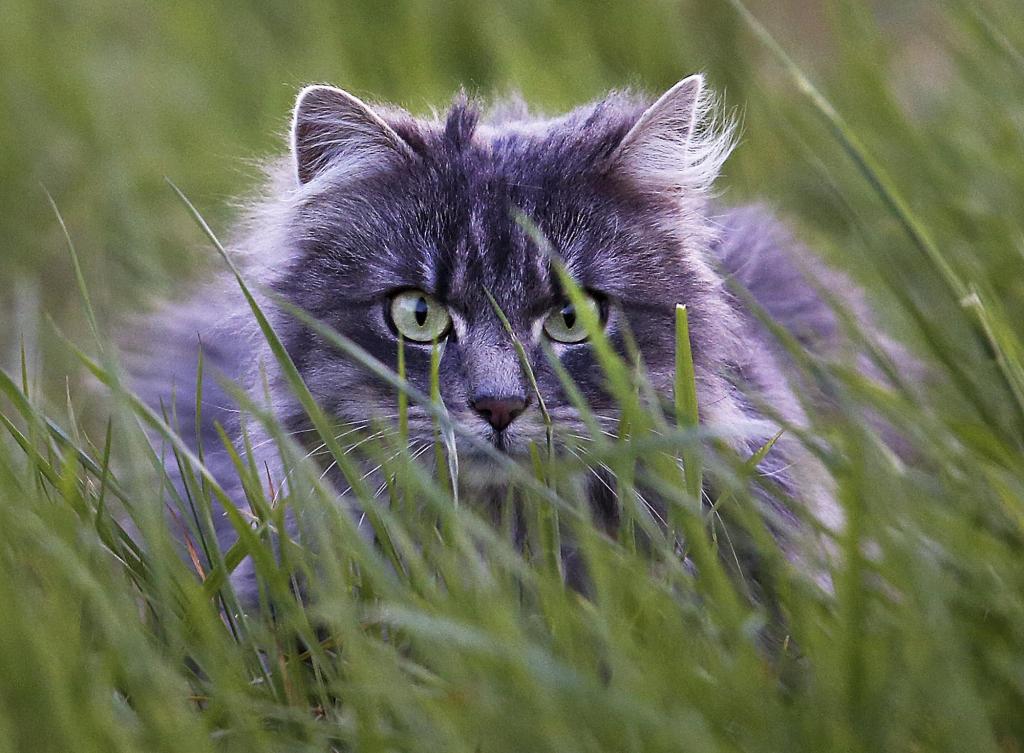News of the weird: German town grounds cats to save rare birds
Published 11:08 am Sunday, May 22, 2022

- A big cat sits in the deep grass in Frankfurt, Germany, Wednesday, April 19, 2017. Authorities in Walldorf, Germany, have ordered some cat owners to keep their pets indoors until the end of August, to protect a rare bird during its breeding season.
BERLIN — What a cat-astrophe!
The decree is designed to help save the crested lark, which makes its nest on the ground and is therefore easy prey for feline hunters. The bird’s population in Western Europe has declined sharply in recent decades.
Authorities in Walldorf wrote that “among other things the survival of the species depends on every single chick.”
The decree, which applies to all cats in the southern part of the town and will be repeated for the coming three years, has reportedly prompted meows of anguish from pet owners.
Regional daily Rhein-Neckar-Zeitung reported that the head of the local animal protection association plans to take legal steps to challenge the decree.
“Please remain calm,” it quoted him as saying. “I can assure you we’ll do our best to stop this disproportionate measure.”
168-year-old Peterboro Basket Co. closing, cites forest pest
PETERBOROUGH, N.H. — A 168-year-old company in New Hampshire known for its handwoven, hardwood baskets is closing its factory and stopping production, partly because of an insect pest that has been destroying ash trees.
The Peterboro Basket Co. has been in business since 1854.
The company said in a recent announcement that the baskets “are principally made of U.S.-grown Appalachian White Ash, the same wood used in ax handles and baseball bats.
“For some years the Emerald Ash Borer beetle has reduced the availability of the wood used to make the baskets,” it said.
The emerald ash borer has destroyed tens of millions of trees in the U.S. and Canada.
The company said other extreme labor shortages, ongoing supply chain issues, and owners who are “ready to retire,” are among the other considerations in deciding to close.
The factory plans to produce its last basket this summer or fall.
Nearly 8,000-year-old skull found in river
REDWOOD FALLS, Minn. — A partial skull that was discovered last summer by two kayakers in Minnesota will be returned to Native American officials after investigations determined it was about 8,000 years old.
The kayakers found the skull in the drought-depleted Minnesota River about 110 miles west of Minneapolis, Renville County Sheriff Scott Hable said.
Thinking it might be related to a missing person case or murder, Hable turned the skull over to a medical examiner and eventually to the FBI, where a forensic anthropologist used carbon dating to determine it was likely the skull of a young man who lived between 5500 and 6000 B.C., Hable said.
“It was a complete shock to us that that bone was that old,” Hable told Minnesota Public Radio.
The anthropologist determined the man had a depression in his skull that was “perhaps suggestive of the cause of death.”
After the sheriff posted about the discovery, his office was criticized by several Native Americans, who said publishing photos of ancestral remains was offensive to their culture.
Hable said his office removed the post.
“We didn’t mean for it to be offensive whatsoever,” Hable said.
Hable said the remains will be turned over to Upper Sioux Community tribal officials.
Minnesota Indian Affairs Council Cultural Resources Specialist Dylan Goetsch said in a statement that neither the council nor the state archaeologist were notified about the discovery, which is required by state laws that govern the care and repatriation of Native American remains.
Goetsch said the Facebook post “showed a complete lack of cultural sensitivity” by failing to call the individual a Native American and referring to the remains as “a little piece of history.”
Kathleen Blue, a professor of anthropology at Minnesota State University, said that the skull was definitely from an ancestor of one of the tribes still living in the area, The New York Times reported.
She said the young man would have likely eaten a diet of plants, deer, fish, turtles and freshwater mussels in a small region, rather than following mammals and bison on their migrations.
“There’s probably not that many people at that time wandering around Minnesota 8,000 years ago, because, like I said, the glaciers have only retreated a few thousands years before that,” Blue said. “That period, we don’t know much about it.”









